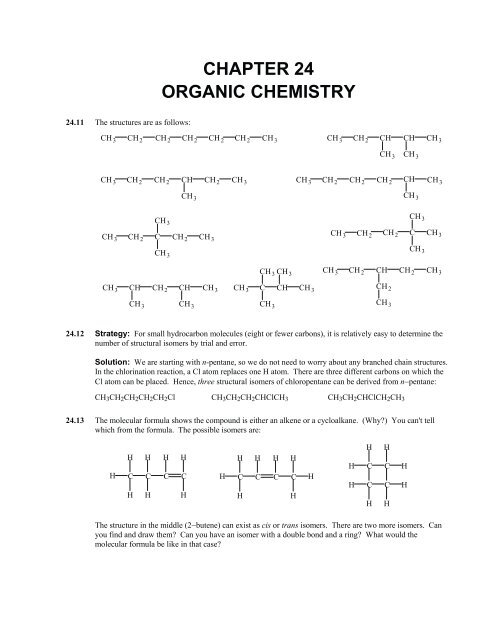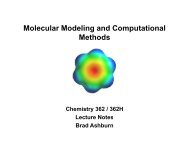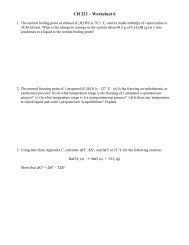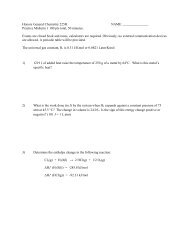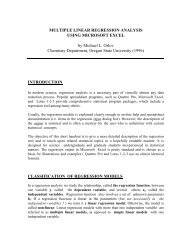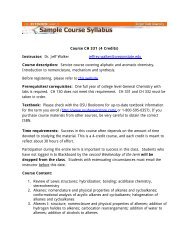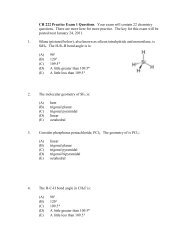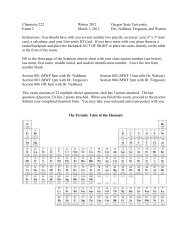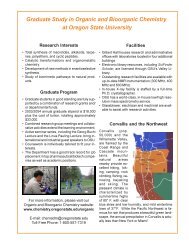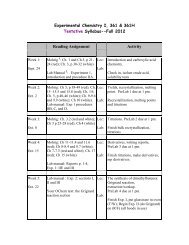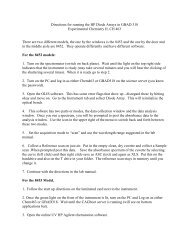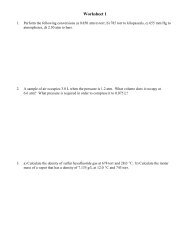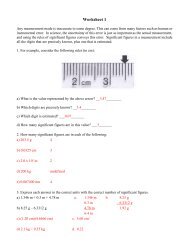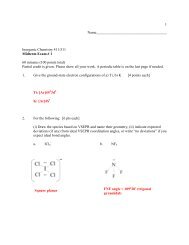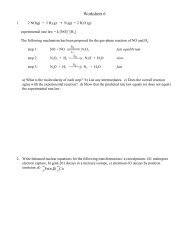You also want an ePaper? Increase the reach of your titles
YUMPU automatically turns print PDFs into web optimized ePapers that Google loves.
656<strong>CHAPTER</strong> <strong>24</strong>: <strong>ORGANIC</strong> <strong>CHEMISTRY</strong><strong>24</strong>.14 Both alkenes and cycloalkanes have the general formula C n H 2n . Let’s start with C 3 H 6 . It could be an alkeneor a cycloalkane.HHCCCH 3HH HCH HC CH HNow, let’s replace one H with a Br atom to form C 3 H 5 Br. Four isomers are possible.H CH 3 BrC CBr H HCH 3C CHH CH 2 BrC CH HH HCH HC CH BrThere is only one isomer for the cycloalkane. Note that all three carbons are equivalent in this structure.<strong>24</strong>.15 The straight chain molecules have the highest boiling points and therefore the strongest intermolecularattractions. Theses chains can pack together more closely and efficiently than highly branched, clusterstructures. This allows intermolecular forces to operate more effectively and cause stronger attractions.<strong>24</strong>.16 (a) This compound could be an alkene or a cycloalkane; both have the general formula, C n H 2n .(b)(c)This could be an alkyne with general formula, C n H 2n−2 . It could also be a hydrocarbon with twodouble bonds (a diene). It could be a cyclic hydrocarbon with one double bond (a cycloalkene).This must be an alkane; the formula is of the C n H 2n+2 type.(d) This compound could be an alkene or a cycloalkane; both have the general formula, C n H 2n .(e)This compound could be an alkyne with one triple bond, or it could be a cyclic alkene (unlikelybecause of ring strain).<strong>24</strong>.17 The two isomers are:H CH 3H 3 CCH 3CCCCH 3 CtransHHcisHA simplified method of presenting the structures is:HCH 3H 3 CCH 3H 3 CtransHHcisHThe cis structure is more crowded and a little less stable. As a result, slightly more heat (energy) would bereleased when the alkene adds a molecule of hydrogen to form butane, C 4 H 10 . Note that butane is theproduct when either alkene is hydrogenated.
<strong>CHAPTER</strong> <strong>24</strong>: <strong>ORGANIC</strong> <strong>CHEMISTRY</strong> 657<strong>24</strong>.18 If cyclobutadiene were square or rectangular, the C−C−C angles must be 90°. If the molecule is diamondshaped,two of the C−C−C angles must be less than 90°. Both of these situations result in a great deal ofdistortion and strain in the molecule. Cyclobutadiene is very unstable for these and other reasons.<strong>24</strong>.19cis-chlorofluoroethylene trans-chlorofluoroethylene 1,1-chlorofluoroethyleneCl FCl HCl HC CC CC CH HH FF H(a) (b) (c)(a) and (b) are geometric isomers.(c) is a structural isomer of both (a) and (b).<strong>24</strong>.20 One compound is an alkane; the other is an alkene. Alkenes characteristically undergo addition reactionswith hydrogen, with halogens (Cl 2 , Br 2 , I 2 ) and with hydrogen halides (HCl, HBr, HI). Alkanes do not reactwith these substances under ordinary conditions.<strong>24</strong>.21 (a) Ethylene is symmetrical; there is no preference in the addition.CH 3 −CH 2 −OSO 3 H(b)The positive part of the polar reagent adds to the carbon atom that already has the most hydrogen atoms.OSO 3 HCH 3 CH CH 3<strong>24</strong>.22 In this problem you are asked to calculate the standard enthalpy of reaction. This type of problem wascovered in Chapter 6.o o oΔ Hrxn = ΣnΔHf (products) − ΣmΔHf(reactants)o o oΔ Hrxn = ΔHf (C6H 6 ) − 3 ΔHf (C2H 2 )You can look up ΔH o fvalues in Appendix 3 of your textbook.oΔH rxn = (1)(49.04 kJ/mol) − (3)(226.6 kJ/mol) = −630.8 kJ/mol<strong>24</strong>.23 (a) CH 2 =CH−CH 2 −CH 3 + HBr → CH 3 −CHBr−CH 2 −CH 3(b) CH 3 −CH=CH−CH 3 + HBr → CH 3 −CH 2 −CHBr−CH 3(a) and (b) are the same.<strong>24</strong>.<strong>24</strong> In this problem you must distinguish between cis and trans isomers. Recall that cis means that two particularatoms (or groups of atoms) are adjacent to each other, and trans means that the atoms (or groups of atoms)are on opposite sides in the structural formula.In (a), the Cl atoms are adjacent to each other. This is the cis isomer. In (b), the Cl atoms are on oppositesides of the structure. This is the trans isomer.
658<strong>CHAPTER</strong> <strong>24</strong>: <strong>ORGANIC</strong> <strong>CHEMISTRY</strong>The names are: (a) cis-1,2-dichlorocyclopropane; and (b) trans-1,2-dichlorocyclopropane.Are any other dichlorocyclopropane isomers possible?<strong>24</strong>.25 (a) and (c)<strong>24</strong>.26 (a) This is a branched hydrocarbon. The name is based on the longest carbon chain. The name is2−methylpentane.(b)(c)(d)(e)(f)This is also a branched hydrocarbon. The longest chain includes the C 2 H 5 group; the name is based onhexane, not pentane. This is an old trick. Carbon chains are flexible and don't have to lie in a straightline. The name is 2,3,4−trimethylhexane. Why not 3,4,5−trimethylhexane?How many carbons in the longest chain? It doesn't have to be straight! The name is 3−ethylhexane.An alkene with two double bonds is called a diene. The name is 3−methyl−1,4−pentadiene.The name is 2−pentyne.The name is 3−phenyl−1−pentene.<strong>24</strong>.27 (a) This is a six-carbon chain with a methyl group on the third carbon.CH 3CH 3 CH 2 CH CH 2 CH 2 CH 3(b)This is a six carbon ring with chlorine atoms on the 1,3, and 5 carbons.HHClHHHClHHClHHNote: The carbon atoms in the ring have been omitted for simplicity.(c)This is a five carbon chain with methyl groups on the 2 and 3 carbons.CH 3CH 3CH CH CH 2 CH 3CH 3(d)This is a five carbon chain with a bromine atom on the second carbon and a phenyl group (a benzenemolecule minus a hydrogen atom, C 6 H 5 ) on the fourth carbon.CH 3 CH CH 2 CHBr CH 3
<strong>CHAPTER</strong> <strong>24</strong>: <strong>ORGANIC</strong> <strong>CHEMISTRY</strong> 659(e)This is an eight carbon chain with methyl groups on the 3, 4, and 5 carbons.CH 3 CH 3 CH 3CH 3 CH 2 CH CH CH CH 2 CH 2 CH 3<strong>24</strong>.28 The hydrogen atoms have been omitted from the skeletal structure for simplicity.H 3 CC C(a) HHHC CCH 2 CH 3 (b) HCH 2 CH 3CH 2 CH 3HH 3 CHCHCHCCH 2 CH 2 CH 3HC C CCH 3(c)CH 2 CH 3(d)<strong>24</strong>.31BrClCH 3CH 3(a)(b)CH 2 CH 2 CH 3(c)CH 3H 3 CCH 3<strong>24</strong>.32 Strategy: We follow the IUPAC rules and use the information in Table <strong>24</strong>.2 of the text. When a benzenering has more than two substituents, you must specify the location of the substituents with numbers.Remember to number the ring so that you end up with the lowest numbering scheme as possible, givingpreference to alphabetical order.Solution:(a) Since a chloro group comes alphabetically before a methyl group, let’s start by numbering the topcarbon of the ring as 1. If we number clockwise, this places the second chloro group on carbon 3 and amethyl group on carbon 4.This compound is 1,3−dichloro−4−methylbenzene.(b)(c)If we start numbering counterclockwise from the bottom carbon of the ring, the name is2−ethyl−1,4−dinitrobenzene. Numbering clockwise from the top carbon gives3−ethyl−1,4−dinitrobenzene.Numbering as low as possible, the correct name is 2−ethyl−1,4−dinitrobenzene.Again, keeping the numbers as low as possible, the correct name for this compound is1,2,4,5−tetramethylbenzene. You should number clockwise from the top carbon of the ring.
660<strong>CHAPTER</strong> <strong>24</strong>: <strong>ORGANIC</strong> <strong>CHEMISTRY</strong><strong>24</strong>.35 (a) There is only one isomer: CH 3 OH(b)There are two structures with this molecular formula:(c)CH 3 −CH 2 −OH and CH 3 −O−CH 3The cyclic di-alcohol has geometric isomers.OOCH 3 CH 2 C OH CH 3 CO CH 3HHOCCHOCHHHHCOCHCOHHHCOHCOHHCHHHH(d)There are two possible alcohols and one ether.CH 3 CH 2 CH 2 OH CH 3 CHCH 3OHCH 3 CH 2 O CH 3<strong>24</strong>.36 Strategy: Learning to recognize functional groups requires memorization of their structural formulas.Table <strong>24</strong>.4 of the text shows a number of the important functional groups.Solution:(a) H 3 C−O−CH 2 −CH 3 contains a C−O−C group and is therefore an ether.(b)(c)(d)(e)(f)(g)This molecule contains an RNH 2 group and is therefore an amine.This molecule is an aldehyde. It contains a carbonyl group in which one of the atoms bonded to thecarbonyl carbon is a hydrogen atom.This molecule also contains a carbonyl group. However, in this case there are no hydrogen atomsbonded to the carbonyl carbon. This molecule is a ketone.This molecule contains a carboxyl group. It is a carboxylic acid.This molecule contains a hydroxyl group (−OH). It is an alcohol.This molecule has both an RNH 2 group and a carboxyl group. It is therefore both an amine and acarboxylic acid, commonly called an amino acid.<strong>24</strong>.37 Aldehydes can be oxidized easily to carboxylic acids. The oxidation reaction is:OOCH 3CH O 2CH 3COH
<strong>CHAPTER</strong> <strong>24</strong>: <strong>ORGANIC</strong> <strong>CHEMISTRY</strong> 661Oxidation of a ketone requires that the carbon chain be broken:OO 2CH 3 C CH 3 3 H 2 O +3CO 2<strong>24</strong>.38 Alcohols react with carboxylic acids to form esters. The reaction is:HCOOH + CH 3 OH ⎯⎯→ HCOOCH 3 + H 2 OThe structure of the product is:OH C O CH 3(methyl formate)<strong>24</strong>.39 Alcohols can be oxidized to ketones under controlled conditions. The possible starting compounds are:OHOHOHCH 3 CH 2 CH 2 CHCH 3CH 3 CH 2 CHCH 2 CH 3(CH 3 ) 2 CHCHCH 3The corresponding products are:OCH 3 CH 2 CH 2 CCH 3OCH 3 CH 2 CCH 2 CH 3O(CH 3 ) 2 CHCCH 3Why isn't the alcohol CH 3 CH 2 CH 2 CH 2 CH 2 OH a possible starting compound?<strong>24</strong>.40 The fact that the compound does not react with sodium metal eliminates the possibility that the substance isan alcohol. The only other possibility is the ether functional group. There are three ethers possible with thismolecular formula:CH 3 −CH 2 −O−CH 2 −CH 3 CH 3 −CH 2 −CH 2 −O−CH 3 (CH 3 ) 2 CH−O−CH 3Light−induced reaction with chlorine results in substitution of a chlorine atom for a hydrogen atom (the otherproduct is HCl). For the first ether there are only two possible chloro derivatives:ClCH 2 −CH 2 −O−CH 2 −CH 3 CH 3 −CHCl−O−CH 2 −CH 3For the second there are four possible chloro derivatives. Three are shown below. Can you draw the fourth?CH 3 −CHCl−CH 2 −O−CH 3 CH 3 −CH 2 −CHCl−O−CH 3 CH 2 Cl−CH 2 −CH 2 −O−CH 3For the third there are three possible chloro derivatives:CH 2 ClCH 3CHO CH 3 CH 3 CHCH 2 ClCH 3 ClO (CH 3 ) 2 CHO CH 3The (CH 3 ) 2 CH−O−CH 3 choice is the original compound.
<strong>CHAPTER</strong> <strong>24</strong>: <strong>ORGANIC</strong> <strong>CHEMISTRY</strong> 663<strong>24</strong>.46 To form a hydrogen bond with water a molecule must have at least one H−F, H−O, or H−N bond, or mustcontain an O, N, or F atom. The following can form hydrogen bonds with water:(a) carboxylic acids (c) ethers (d) aldehydes (f) amines<strong>24</strong>.47 (a) The empirical formula is:H:C:F:1molH3.2 g H × = 3.17 mol H1.008 g H1molC37.5 g C × = 3.12 mol C12.01 g C1molF59.3 g F × = 3.12 mol F19.00 g FThis gives the formula, H 3.17 C 3.12 F 3.12 . Dividing by 3.12 gives the empirical formula, HCF.(b)When temperature and amount of gas are constant, the product of pressure times volume is constant(Boyle's law).(2.00 atm)(0.322 L) = 0.664 atm⋅L(1.50 atm)(0.409 L) = 0.614 atm⋅L(1.00 atm)(0.564 L) = 0.564 atm⋅L(0.50 atm)(1.028 L) = 0.514 atm⋅LThe substance does not obey the ideal gas law.(c)Since the gas does not obey the ideal gas equation exactly, the molar mass will only be approximate.Gases obey the ideal gas law best at lowest pressures. We use the 0.50 atm data.PV (0.50 atm)(1.028 L)n = = = 0.0172 molRT (0.0821 L ⋅atm/K ⋅mol)(363 K)Molar mass1.00 g= =0.0172 mol58.1 g/molThis is reasonably close to C 2 H 2 F 2 (64 g/mol).(d)The C 2 H 2 F 2 formula is that of difluoroethylene. Three isomers are possible. The carbon atoms areomitted for simplicity (see Problem <strong>24</strong>.17).HFFFHFHFHHFHOnly the third isomer has no dipole moment.(e)The name is trans−difluoroethylene.<strong>24</strong>.48 (a) rubbing alcohol (b) vinegar (c) moth balls (d) organic synthesis(e) organic synthesis (f) antifreeze (g) fuel (natural gas) (h) synthetic polymers
664<strong>CHAPTER</strong> <strong>24</strong>: <strong>ORGANIC</strong> <strong>CHEMISTRY</strong><strong>24</strong>.49 In any stoichiometry problem, you must start with a balanced equation. The balanced equation for thecombustion reaction is:2C 8 H 18 (l) + 25O 2 (g) → 16CO 2 (g) + 18H 2 O(l)To find the number of moles of octane in one liter, use density as a conversion factor to find grams of octane,then use the molar mass of octane to convert to moles of octane. The strategy is:L octane → mL octane → g octane → mol octane1000 mL 0.70 g C8H18 1 mol C8H181.0 L × × × = 6.13 mol C8H181L 1mLC8H18 114.2gC8H18Using the mole ratio from the balanced equation, the number of moles of oxygen used is:25 mol O6.13 mol C 28H18 × = 76.6 mol O22molC8H18From the ideal gas equation, we can calculate the volume of oxygen.VO2nO RT (76.6 mol)(293 K) 0.0821 L ⋅atm31.84 10 LP 1.00 atm mol⋅K2= = × = ×Air is only 22% O 2 by volume. Thus, 100 L of air will contain 22 L of O 2 . Setting up the appropriateconversion factor, we find that the volume of air is:3 100 L air3? vol of air = (1.84 × 10 L O 2)× = 8.4 × 10 L air22 L O2<strong>24</strong>.50 (a) 2−butyne has three C−C sigma bonds.(b)Anthracene is:There are sixteen C−C sigma bonds.(c)CCCCCThere are six C−C sigma bonds.<strong>24</strong>.51 (a) A benzene ring has six carbon-carbon bonds; hence, benzene has six C−C sigma bonds.(b)Cyclobutane has four carbon-carbon bonds; hence, cyclobutane has four sigma bonds.
<strong>CHAPTER</strong> <strong>24</strong>: <strong>ORGANIC</strong> <strong>CHEMISTRY</strong> 665(c)Looking at the carbon skeleton of 3−ethyl−2−methylpentane, you should find seven C−C sigma bonds.C C C C CC CC<strong>24</strong>.52 (a) The easiest way to calculate the mg of C in CO 2 is by mass ratio. There are 12.01 g of C in 44.01 gCO 2 or 12.01 mg C in 44.01 mg CO 2 .12.01 mg C? mg C = 57.94 mg CO2×44.01 mg CO2= 15.81 mg CSimilarly,? mg H =2.016 mg H11.85 mg H2O × 18.02 mg H 2 O= 1.326 mg HThe mg of oxygen can be found by difference.? mg O = 20.63 mg Y − 15.81 mg C − 1.326 mg H = 3.49 mg O(b)Step 1: Calculate the number of moles of each element present in the sample. Use molar mass as aconversion factor.−3 1molC−3? mol C = (15.81 × 10 g C) × = 1.316 × 10 mol C12.01 g CSimilarly,−3 1molH−3? mol H = (1.326 × 10 g H) × = 1.315 × 10 mol H1.008 g H−3 1molO−4? mol O = (3.49 × 10 g O) × = 2.18 × 10 mol O16.00 g OThus, we arrive at the formula C −3 H −3 O−4, which gives the identity and the1.316 × 10 1.315 × 10 2.18 × 10ratios of atoms present. However, chemical formulas are written with whole numbers.Step 2: Try to convert to whole numbers by dividing all the subscripts by the smallest subscript.C:1.316 × 102.18 × 10−3−4= 6.04 ≈ 6H:1.315 × 102.18 × 10−3−4= 6.03 ≈ 6O:2.18 × 102.18 × 10−4−4=1.00This gives us the empirical formula, C 6 H 6 O.(c)The presence of six carbons and a corresponding number of hydrogens suggests a benzene derivative.A plausible structure is shown below.OH
666<strong>CHAPTER</strong> <strong>24</strong>: <strong>ORGANIC</strong> <strong>CHEMISTRY</strong><strong>24</strong>.53 The structural isomers are:1,2−dichlorobutaneCH*3 CH 2 CHCl CH 2 Cl1,3−dichlorobutaneCH 3 CHCl*CH 2 CH 2 Cl2,3−dichlorobutane1,4−dichlorobutaneCH*3 CHCl* CHCl CH3 CH 2 Cl CH 2 CH 2 CH 2 Cl1,1−dichlorobutane2,2−dichlorobutaneCH 3 CH 2 CH 2 CHCl 2 CH 3 CH 2 CCl 2 CH 31,3−dichloro−2−methylpropaneCH 2 Cl CH CH 2 ClCH 31,2−dichloro−2−methylpropaneCH 3 CCl CH 2 ClCH 31,1−dichloro−2−methylpropaneCH 3 CH CHCl 2CH 3The asterisk identifies the asymmetric carbon atom.<strong>24</strong>.54 First, calculate the moles of each element.C:H:−3 1molCO21molC−4(9.708 × 10 g CO 2) × × = 2.206 × 10 mol C44.01 g CO2 1 mol CO2−3 1molH2O2molH−4(3.969 × 10 g H2O) × × = 4.405 × 10 mol H18.02 g H2O 1 mol H2OThe mass of oxygen is found by difference:3.795 mg compound − (2.649 mg C + 0.445 mg H) = 0.701 mg OO:−3 1molO−5(0.701 × 10 g O) × = 4.38 × 10 mol O16.00 g OThis gives the formula is C −4 H −4 O−5. Dividing by the smallest number of moles2.206 × 10 4.405 × 10 4.38 × 10gives the empirical formula, C 5 H 10 O.We calculate moles using the ideal gas equation, and then calculate the molar mass.nPV (1.00 atm)(0.0898 L)= = =RT (0.0821 L ⋅atm/K ⋅mol)(473 K)0.00231 molmolar mass= g of substance 0.205 gmol of substance= 0.00231 mol= 88.7 g/mol
<strong>CHAPTER</strong> <strong>24</strong>: <strong>ORGANIC</strong> <strong>CHEMISTRY</strong> 667The formula mass of C 5 H 10 O is 86.13 g, so this is also the molecular formula. Three possible structures are:H 2 CH 2 CCH 2OH 2 C CH 2CH 2H 2 C CHCH 2OCH 3 H2 C CH CH 2 O CH 2 CH 3<strong>24</strong>.55 (a) In comparing the compound in part (a) with the starting alkyne, it is clear that a molecule of HBr hasbeen added to the triple bond. The reaction is:CH 3 Br CH 3H C C CH CH 3 + HBr H C C CH CH 3H(b)(c)This compound can be made from the product formed in part (a) by addition of bromine to the doublebond.BrCH 3H 2 C C CH CH 3+ Br 2BrH 2 CBrCBrCH 3CH CH 3This compound can be made from the product of part (a) by addition of hydrogen to the double bond.BrCH 3HBrH 2 C C CH CH 3+ H 2 H 2 CCCH 3CH CH 3H<strong>24</strong>.56 A carbon atom is asymmetric if it is bonded to four different atoms or groups. In the given structures theasymmetric carbons are marked with an asterisk (*).(a)CH 3CH 3 CH 2 CH**CHNH 2OCNH 2(b)HHH*BrH*Br
668<strong>CHAPTER</strong> <strong>24</strong>: <strong>ORGANIC</strong> <strong>CHEMISTRY</strong><strong>24</strong>.57 The isomers are:ClClClClClClClClDid you have more isomers? Remember that benzene is a planar molecule; "turning over" a structure doesnot create a new isomer.<strong>24</strong>.58 Acetone is a ketone with the formula, CH 3 COCH 3 . We must write the structure of an aldehyde that has thesame number and types of atoms (C 3 H 6 O). Removing the aldehyde functional group (−CHO) from theformula leaves C 2 H 5 . This is the formula of an ethyl group. The aldehyde that is a structural isomer ofacetone is:OCH 3 CH 2 CH<strong>24</strong>.59 The structures are:H 2(a) (b) H 3 CCH 3 (c)CC CH 2 C CH 2HHH 2 C CH 2OH H H HH 3 C C C C C CH 3H H H H(d)BrBr(e)CH 3CC CH 3<strong>24</strong>.60 (a) alcohol (b) ether (c) aldehyde (d) carboxylic acid (e) amine<strong>24</strong>.61 Ethanol has a melting point of −117.3°C, a boiling point of +78.5°C, and is miscible with water. Dimethylether has a melting point of −138.5°C, a boiling point of −25°C (it is a gas at room temperature), anddissolves in water to the extent of 37 volumes of gas to one volume of water.<strong>24</strong>.62 In Chapter 11, we found that salts with their electrostatic intermolecular attractions had low vapor pressuresand thus high boiling points. Ammonia and its derivatives (amines) are molecules with dipole−dipoleattractions. If the nitrogen has one direct N−H bond, the molecule will have hydrogen bonding. Even so,these molecules will have much weaker intermolecular attractions than ionic species and hence higher vaporpressures. Thus, if we could convert the neutral ammonia−type molecules into salts, their vapor pressures,and thus associated odors, would decrease. Lemon juice contains acids which can react with ammonia−type(amine) molecules to form ammonium salts.NH 3 + H + ⎯⎯→ NH 4+RNH 2 + H + ⎯⎯→ RNH 3+
<strong>CHAPTER</strong> <strong>24</strong>: <strong>ORGANIC</strong> <strong>CHEMISTRY</strong> 669<strong>24</strong>.63 Cyclohexane readily undergoes halogenation; for example, its reaction with bromine can be monitored byseeing the red color of bromine fading. Benzene does not react with halogens unless a catalyst is present.<strong>24</strong>.64 Marsh gas (methane, CH 4 ); grain alcohol (ethanol, C 2 H 5 OH); wood alcohol (methanol, CH 3 OH); rubbingalcohol (isopropyl alcohol, (CH 3 ) 2 CHOH); antifreeze (ethylene glycol, CH 2 OHCH 2 OH); mothballs(naphthalene, C 10 H 8 ); vinegar (acetic acid, CH 3 COOH).<strong>24</strong>.65 A mixture of cis and trans isomers would imply some sort of random addition mechanism in which onehydrogen atom at a time adds to the molecule.The formation of pure cis or pure trans isomer indicates a more specific mechanism. For example, a pure cisproduct suggests simultaneous addition of both hydrogen atoms in the form of a hydrogen molecule to oneside of the alkyne. In practice, the cis isomer is formed.<strong>24</strong>.66 The asymmetric carbons are shown by asterisks:H H HOH CH 3(a) H C*C C Cl(b) CH * 3 C * C CH 2 OHHClHHH(c)All of the carbon atoms in the ring are asymmetric. Therefore there are five asymmetric carbon atoms.<strong>24</strong>.67 (a) Sulfuric acid ionizes as follows:H 2 SO 4 (aq) ⎯⎯→ H + (aq) + HSO 4− (aq)The cation (H + ) and anion (HSO 4− ) add to the double bond in propene according to Markovnikov’srule:CH 3 CH CH 2 + H + + HSO 4−Reaction of the intermediate with water yields isopropanol:CH 3OSO 3 HCHCH 3OSO 3 HOHCH 3CCH 3 + H 2 O CH 3CCH 3 + H 2 SO 4HHSince sulfuric acid is regenerated, it plays the role of a catalyst.(b)The other structure containing the −OH group isCH 3 −CH 2 −CH 2 −OHpropanol(c)From the structure of isopropanol shown above, we see that the molecule does not have an asymmetriccarbon atom. Therefore, isopropanol is achiral.
670<strong>CHAPTER</strong> <strong>24</strong>: <strong>ORGANIC</strong> <strong>CHEMISTRY</strong>(d)Isopropanol is fairly volatile (b.p. = 82.5°C), and the −OH group allows it to form hydrogen bonds withwater molecules. Thus, as it evaporates, it produces a cooling and soothing effect on the skin. It is alsoless toxic than methanol and less expensive than ethanol.<strong>24</strong>.68 The red bromine vapor absorbs photons of blue light and dissociates to form bromine atoms.Br 2 → 2Br•The bromine atoms collide with methane molecules and abstract hydrogen atoms.Br• + CH 4 → HBr + •CH 3The methyl radical then reacts with Br 2 , giving the observed product and regenerating a bromine atom tostart the process over again:•CH 3 + Br 2 → CH 3 Br + Br•Br• + CH 4 → HBr + •CH 3and so on...<strong>24</strong>.69 From the molar mass of the alkene, we deduce that there can only be 3 carbon atoms. Therefore, the alkeneis CH 2 =CH−CH 3 (propene). The reactions are:H 2 SO 4H 2 C CH CH 3 H 3 C CH CH 3H 2 OMarkovnikov's ruleOHK 2 Cr 2 O 7H +OH 3 C C CH 3<strong>24</strong>.70 2−butanone isOH 3 C C CH 2CH 3Reduction with LiAlH 4 produces 2-butanol.OHH 3 C C CH 2HCH 3This molecule possesses an asymmetric carbon atom and should be chiral. However, the reduction producesan equimolar d and l isomers; that is, a racemic mixture (see Section 22.4 of the text). Therefore, the opticalrotation as measured in a polarimeter is zero.
<strong>CHAPTER</strong> <strong>24</strong>: <strong>ORGANIC</strong> <strong>CHEMISTRY</strong> 671<strong>24</strong>.71 The structures of three alkenes that yield 2-methylbutaneCH 3CH 3 CHCH 2 CH 3on hydrogenation are:H 2 CCH 3CH 2 CH 3H 3 C CCCH 3 CH 3CH CH 3 H 3 C CH CH CH 2<strong>24</strong>.72 To help determine the molecular formula of the alcohol, we can calculate the molar mass of the carboxylicacid, and then determine the molar mass of the alcohol from the molar mass of the acid. Grams of carboxylicacid are given (4.46 g), so we need to determine the moles of acid to calculate its molar mass.The number of moles in 50.0 mL of 2.27 M NaOH is2.27 mol NaOH 50.0 mL 0.1135 mol NaOH1000 mL soln × =The number of moles in 28.7 mL of 1.86 M HCl is1.86 mol HCl28.7 mL 0.05338 mol HCl1000 mL soln × =The difference between the above two numbers is the number of moles of NaOH reacted with the carboxylicacid.0.1135 mol − 0.05338 mol = 0.06012 molThis is the number of moles present in 4.46 g of the carboxylic acid. The molar mass isM4.46 g= =0.06012 mol74.18 g/molA carboxylic acid contains a −COOH group and an alcohol has an −OH group. When the alcohol is oxidizedto a carboxylic acid, the change is from −CH 2 OH to −COOH. Therefore, the molar mass of the alcohol is74.18 g − 16 g + (2)(1.008 g) = 60.2 g/molWith a molar mass of 60.2 g/mol for the alcohol, there can only be 1 oxygen atom and 3 carbon atoms in themolecule, so the formula must be C 3 H 8 O. The alcohol has one of the following two molecular formulas.CH 3 CH 2 CH 2 OHOHH 3 C CH CH 3
672<strong>CHAPTER</strong> <strong>24</strong>: <strong>ORGANIC</strong> <strong>CHEMISTRY</strong><strong>24</strong>.73 There are 18 structural isomers and 10 of them are chiral. The asymmetric carbon atoms are marked with anasterisk.C C C C C COHC C C C *C COHOHC C C *C C C3CCC C CCCOHC C CCCCCC COH*C CC OHOHCC *COHCCC5C C *CCCCC C *C C CC OHC C C *C COHCC C C C COHC OHC C C C C4CCC C *C COHC CC C C CC C OHC C *C C3OHCCOHCOHC C CCOHC C *CC C C CC3CCC
<strong>CHAPTER</strong> <strong>24</strong>: <strong>ORGANIC</strong> <strong>CHEMISTRY</strong> 673<strong>24</strong>.74 (a) Reaction between glycerol and carboxylic acid (formation of an ester).(b)OCH 2 O COCH O C R'OCH 2 O CA fat or oilRR''NaOHH 2 OCH 2CHCH 2OHOHOHGlycerol+ 3ROCO − Na +Fatty acid salts(soap)(c)(d)(e)Molecules having more C=C bonds are harder to pack tightly together. Consequently, the compoundhas a lower melting point.H 2 gas with either a heterogeneous or homogeneous catalyst would be used. See Section 13.6 of thetext.Number of moles of Na 2 S 2 O 3 reacted is:1L 0.142 mol Na2S2O3−320.6 mL × × = 2.93 × 10 mol Na2S2O31000 mL 1 LThe mole ratio between I 2 and Na 2 S 2 O 3 is 1:2. The number of grams of I 2 left over is:−3 1 mol I2 253.8 g I(2.93 × 10 mol Na 22S2O 3) × × = 0.372 g I22molNa2SO2 3 1molI2Number of grams of I 2 reacted is: (43.8 − 0.372)γ = 43.4 g I 2The iodine number is the number of grams of iodine that react with 100 g of corn oil.43.4 g Iiodine number = 2 × 100 g corn oil = 12335.3 g corn oil


